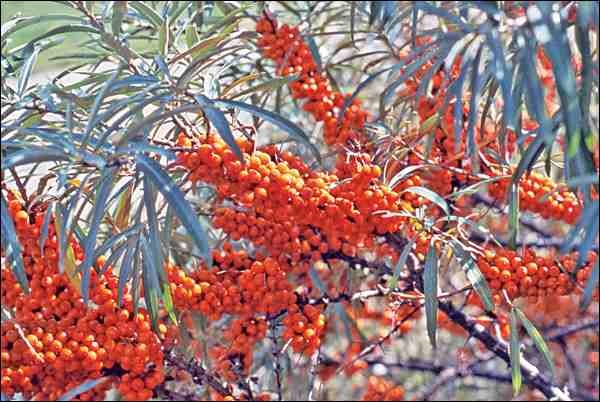Native to Europe and Asia, sea buckthorn (Hippophae rhamnoides) has a long, continuous history of medicinal use and has been planted extensively in Russian shelterbelts. Its fruit is high in vitamin C while the oil extracted from the fruit has been used to treat burns.
It's a large, upright shrub up to 3.7 metres tall, suckers prodigiously and sports twigs that end in downright dangerous thorns. The leaves are narrow and silver, and the flowers are small, yellow and inconspicuous. Both drought and saline tolerant, sea buckthorn should be grown in full sun and does well in sandy soils. There are separate male (pollen source) and female (fruit producing) plants. Both are required (one male to seven female) to produce fruit.
This is a shrub for farmyards, acreages, shelterbelts and highway allowances. Although its suckering habit precludes its use is smaller urban settings, you may find it on a winter walk still loaded with fruit.
The yellow, orange or red fruit is held close to the branches. The Russian name, oblepeekha, translates as "glued-on berries" and is a very fair assessment of the difficulty involved in removing the fruit from the stems. Because the fruit persists over winter, you have a while yet to tackle the task. Once "stemmed" (or "de-stemmed") they are excellent for jelly, preserves, liqueur or gelato.
Over the last two decades, the Agroforestry Development Centre (formerly the Prairie Farm Rehabilitation Administration station) at Indian Head carried out extensive research, selecting cultivars with fewer thorns, good yields and larger and less "glued-on" fruit. Two of these selections are Harvest Moon and Orange September.
If the plant is yours or you have permission from the owner, take a pair of secateurs and cut off about 20 to 30 centimetres of the fruiting stems, remembering the sharp thorns found at the ends. Inside, rinse the stems under cold water to remove clinging leaves and other debris. To remove the berries, hold the stem upright and below the rim of a pail, position your thumb and forefinger firmly on the stem above the berries and run your fingers down the stem, taking care to push the berries off the stem as intact as possible to keep the skins with the pulp. This is a slow, messy process.
Here's the recipe I used, from the PFRA booklet, Fruit-bearing Shrubs for Multi-use Shelterbelts and Orchards. Once removed from the stems, thoroughly crush the fruit. Add one cup of water and bring to a boil, simmering for 10 minutes. Place the cooked fruit in a jelly bag and squeeze to extract the juice. (As it was after 11 p.m. by the time I got to this stage, I left it hanging overnight with excellent results.) Measure out five cups of juice. If you don't have five cups, add up to one-half cup of water or fruit nectar [I suggest apricot]. Place the juice in a large saucepan. Add seven cups of sugar - do not reduce! Place over high heat and bring to a full boil, stirring constantly. Add one-half teaspoon butter to reduce foam if desired. Immediately stir in one pouch of liquid pectin and continue to stir until mixture returns to a full rolling boil. Boil hard for one minute, stirring constantly.
Remove from heat and skim. Pour quickly into warm sterilized jars and fill leaving five millimetres headspace. Seal with two-piece lids. Makes eight cups of a gorgeous orange jelly, which is excellent on toast or over ice cream! It's not too late
- Williams is the author of the newly revised and expanded Creating the Prairie Xeriscape and with co-author Hugh Skinner Gardening Naturally. Join Sara this spring on a history, culture and garden tour of Ireland. Stay tuned for details. This column is provided courtesy of the Saskatchewan Perennial Society (www.saskperennial.ca; [email protected]).
Upcoming events
Nov. 27, 7:30 p.m. - City Flower Barrel Program. Join Moira Moser as she describes what goes into the choice of plants, care and maintenance of Saskatoon's fabulous flower barrels found throughout the city. St. James Anglican Church, 607 Dufferin Ave. Side door. Free.




